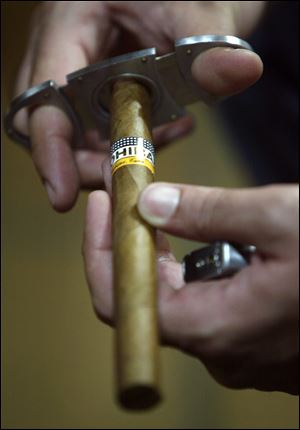
Cigar-smuggling pigeons to touch down at New York gallery
10/23/2013
A Cuban cigar.
NEW YORK - Thanks to New York City artist Duke Riley, the American surveillance apparatus faces a new airborne foe: the homing pigeon.
Riley trained pigeons to smuggle Cuban cigars from Havana, Cuba, to Key West, Florida, while other birds filmed the 100-mile (160-km) journey with custom-made cameras. The pigeons and their videos will be on display in Riley's solo show, which opens November 1 at the Magnan Metz gallery in New York.
Riley, 41, said he came up with the project at least in part to challenge the idea that the spying capabilities of the U.S. government have become all-encompassing.
He started with 50 birds - tagging half of them as smugglers and the other half as documentarians.
“A lot of the work I do seeks to create some sense of possibility or empowerment, in a humorous and romanticized way, using the simplest means possible,” Riley said.
It was also Riley's way of protesting the 51-year-old U.S. embargo against Cuba. Under the 1917 Trading with the Enemy Act, the United States has enforced economic sanctions against Cuba since 1962.
More recently, Americans with permission to travel to Cuba were allowed to bring back $100 worth of goods, but the Bush administration ratcheted up sanctions in 2004, imposing a total ban.
Riley's cigar project aims for more than just subversion.
“I don't want to - can I say it? - be pigeonholed,” said Riley, who has been around pigeons since he was a child. He spent years researching their role in carrying information for the military - more recently for the U.S. Navy during the Vietnam War.
Still, Riley has long courted trouble with his artistic interventions. In 2007, he was arrested by the U.S. Coast Guard for approaching the Red Hook-berthed Queen Mary II cruise liner in a makeshift wooden Revolutionary War-era submarine. Riley called that project commentary on the Bush administration's “war on terror” and the gentrification of the Brooklyn waterfront, where he works as a tattoo artist.
In 2009, Riley hopped freight trains on his way to Cleveland, Ohio, and infiltrated the city's sewer system to emulate the hobo lifestyle of migrant workers during Cleveland's Depression-era.
If some of that artistry bordered on illegality, the latest project, four years in the making, dives straight in. Normally outspoken - “If you're an artist and not taking risks, you're really just masturbating” - Riley became more guarded when discussing how the pigeons got to and from Cuba.
Less than half of the original number of his trainees took part in the mission. Of the 23 birds that embarked on it, only 11 made it back - toting six Cohibas. Those cigars are now cast in resin and also on display.
A 12th bird, D. Ruggero Deodato, nose-dived into Havana harbor under uncertain circumstances. The bird survived and made its way back to the United States without any cargo.
“I imagine Cuban authorities would be sensitive to American pigeons flying over with cameras - that that would cause some alarm,” Riley said, grinning. “But I'm just speculating.”
Some of the pigeons are now awaiting exhibition in a bird loft at the Magnan Metz Gallery, surrounded by portraits of each of the 50 participants painted on tin shingles. The loft, installed on Monday, is decorated with parts of two shipwrecks Riley scavenged along with Key West objects like street signs and lobster traps.
The pigeons are already breeding. What are the artist's plans for the offspring? “Train them to smuggle more cigars," Riley said with a laugh. “Or cocaine from Colombia.”
Joking aside, the United States will be watching.
A spokeswoman for the Joint Interagency Taskforce South, which monitors such activity, said:
“If we had some intel that the pigeons are involved in drugs, or in international crime, or illicit trafficking, we would use whatever assets we have to obtain that information." (Reporting by Luke Swiderski; Editing by Daniel Trotta and Gunna Dickson)